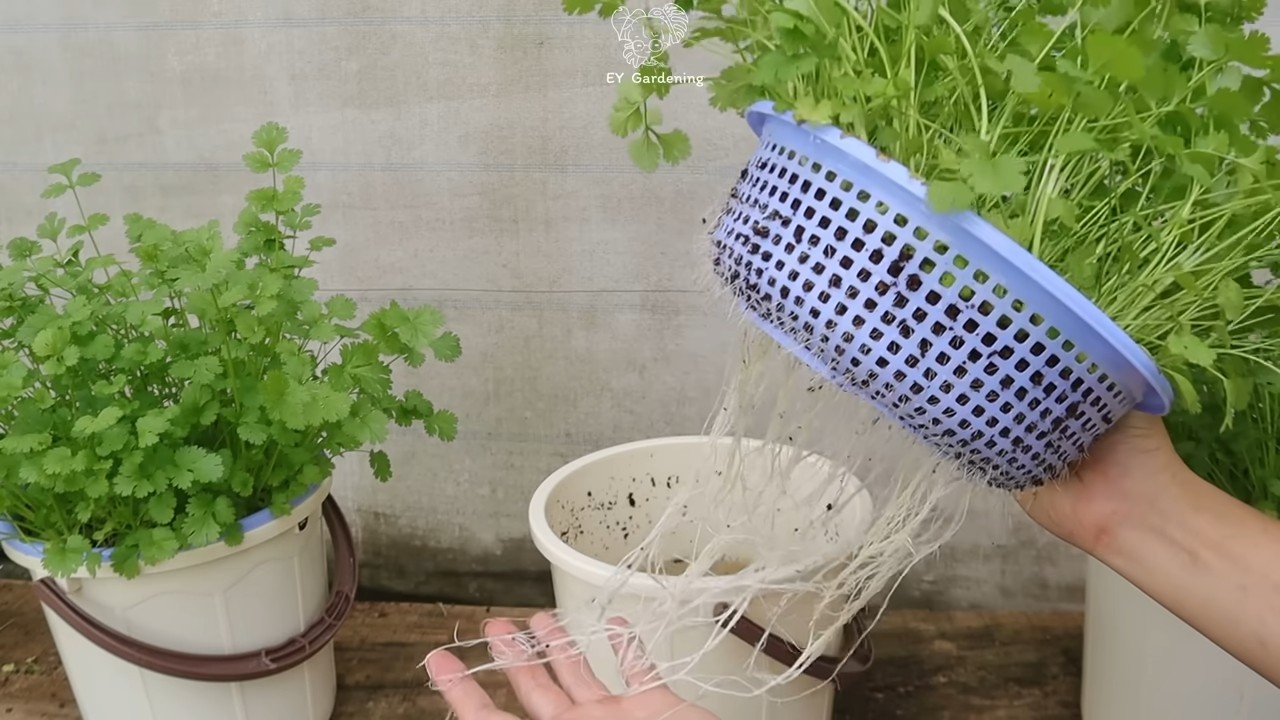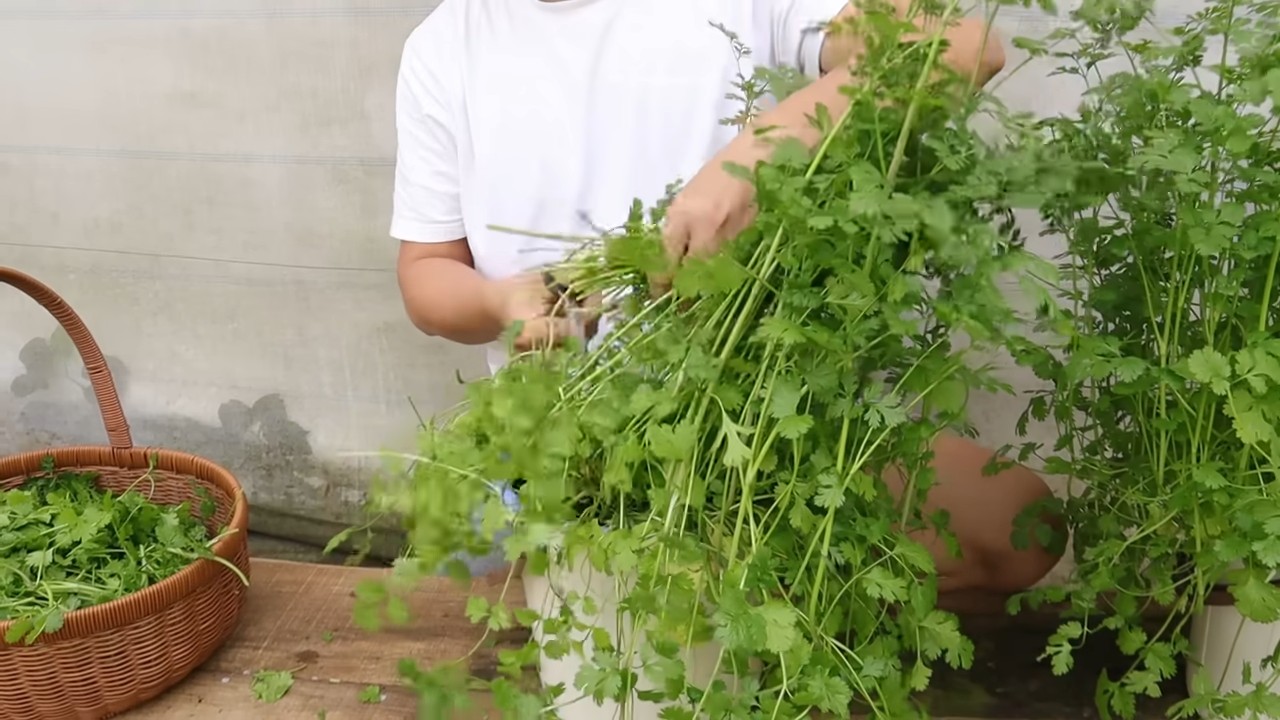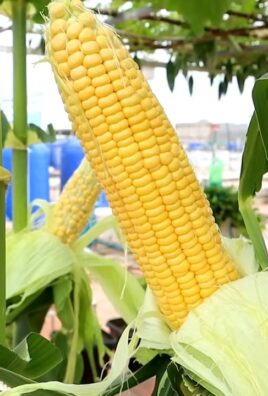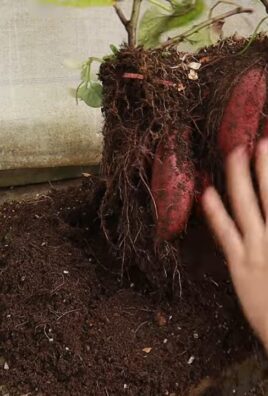Growing coriander in water might sound like something only seasoned gardeners can achieve, but trust me, it’s a surprisingly simple and rewarding DIY project that anyone can tackle! Are you tired of buying bunches of coriander only to have them wilt away in your fridge before you can use them? I know I am! That’s why I’m so excited to share this game-changing trick that will keep you stocked with fresh coriander, ready to add a burst of flavor to your favorite dishes.
Coriander, also known as cilantro, has a rich history, dating back thousands of years. Evidence suggests it was cultivated in ancient Egypt and used for both culinary and medicinal purposes. Its vibrant flavor has made it a staple in cuisines around the world, from Mexican salsas to Indian curries. But let’s face it, keeping fresh herbs alive can be a challenge, especially if you don’t have a green thumb or a sprawling garden.
That’s where this DIY hack comes in! Growing coriander in water is the perfect solution for urban dwellers, apartment residents, or anyone who wants a constant supply of this flavorful herb without the hassle of traditional gardening. It’s a cost-effective, space-saving, and incredibly easy way to enjoy fresh coriander whenever you need it. So, ditch the wilted bunches and get ready to embark on a journey to fresh, homegrown flavor!

Koriander in Wasser ziehen: So klappt’s!
Hey Leute! Habt ihr auch manchmal das Problem, dass euer Koriander im Topf eingeht, bevor ihr ihn überhaupt aufbrauchen könnt? Oder dass er einfach nicht so richtig wachsen will? Keine Sorge, ich hab da einen super einfachen Trick für euch, wie ihr Koriander in Wasser ziehen und so länger frisch halten könnt! Und das Beste: Es ist super easy und ihr braucht fast nichts dafür. Los geht’s!
Was du brauchst:
* Ein Bund frischen Koriander (am besten aus dem Supermarkt oder vom Markt)
* Ein sauberes Glas oder eine Vase
* Wasser (am besten gefiltert oder abgestandenes Leitungswasser)
* Optional: Eine Plastiktüte oder Frischhaltefolie
Schritt-für-Schritt-Anleitung:
1. Koriander vorbereiten: Zuerst müsst ihr den Koriander vorbereiten. Nehmt den Bund Koriander und schaut ihn euch genau an. Entfernt alle gelben, welken oder beschädigten Blätter. Diese würden nur das Wasser verunreinigen und den restlichen Koriander schneller verderben lassen. Schneidet die Stiele etwa 2-3 cm oberhalb der Wurzeln ab. So können sie besser Wasser aufnehmen.
2. Glas vorbereiten: Sucht euch ein sauberes Glas oder eine Vase aus. Es sollte nicht zu klein sein, damit der Koriander genug Platz hat. Reinigt das Glas gründlich mit Spülmittel und heißem Wasser, um sicherzustellen, dass keine Bakterien oder Pilze vorhanden sind, die den Koriander schädigen könnten.
3. Wasser einfüllen: Füllt das Glas mit frischem Wasser. Achtet darauf, dass das Wasser nicht zu kalt ist, Zimmertemperatur ist ideal. Ich verwende am liebsten gefiltertes Wasser oder abgestandenes Leitungswasser, da es weniger Chlor enthält, was dem Koriander schaden könnte. Das Wasser sollte die Stiele des Korianders etwa 2-3 cm bedecken.
4. Koriander ins Wasser stellen: Stellt den vorbereiteten Koriander vorsichtig in das Glas mit Wasser. Achtet darauf, dass die Blätter nicht im Wasser sind, da sie sonst schnell faulen. Wenn nötig, könnt ihr ein paar Blätter unten am Stiel entfernen, damit nur die Stiele im Wasser stehen.
5. Standort wählen: Sucht einen geeigneten Standort für euer Koriander-Glas. Am besten ist ein heller, aber nicht direkter Sonnenplatz. Direkte Sonneneinstrahlung kann die Blätter verbrennen und das Wasser schneller erwärmen, was das Wachstum von Bakterien fördert. Ein Platz auf der Fensterbank, der morgens oder abends etwas Sonne abbekommt, ist ideal.
6. Wasser regelmäßig wechseln: Das ist super wichtig! Wechselt das Wasser alle ein bis zwei Tage. So verhindert ihr, dass sich Bakterien bilden und der Koriander schneller verdirbt. Spült dabei auch das Glas kurz aus, um eventuelle Ablagerungen zu entfernen.
7. Optional: Abdeckung verwenden: Wenn ihr wollt, könnt ihr den Koriander mit einer Plastiktüte oder Frischhaltefolie abdecken. Das sorgt für eine höhere Luftfeuchtigkeit und kann das Wachstum fördern. Achtet aber darauf, dass die Tüte nicht direkt auf den Blättern liegt, da sie sonst faulen könnten. Macht am besten ein paar kleine Löcher in die Tüte, damit die Luft zirkulieren kann.
8. Beobachten und ernten: Beobachtet euren Koriander regelmäßig. Ihr werdet sehen, dass er innerhalb weniger Tage anfängt, neue Wurzeln zu bilden und frische Blätter zu wachsen. Ihr könnt die Blätter nach Bedarf ernten, indem ihr sie einfach mit einer Schere abschneidet. Achtet darauf, nicht zu viele Blätter auf einmal zu ernten, damit der Koriander weiterwachsen kann.
Tipps und Tricks für noch mehr Erfolg:
* Koriander-Sorte wählen: Es gibt verschiedene Koriander-Sorten. Einige sind besser für den Anbau in Wasser geeignet als andere. Fragt am besten im Supermarkt oder auf dem Markt nach, welche Sorte sie empfehlen.
* Wasserqualität: Wie bereits erwähnt, ist die Wasserqualität sehr wichtig. Verwendet am besten gefiltertes Wasser oder abgestandenes Leitungswasser. Wenn ihr Leitungswasser verwendet, lasst es am besten ein paar Stunden stehen, damit das Chlor verdunsten kann.
* Luftfeuchtigkeit erhöhen: Koriander mag eine hohe Luftfeuchtigkeit. Ihr könnt die Luftfeuchtigkeit erhöhen, indem ihr das Glas mit dem Koriander in die Nähe einer Schale mit Wasser stellt oder die Blätter regelmäßig mit Wasser besprüht.
* Düngen: Wenn ihr wollt, könnt ihr dem Wasser ab und zu etwas Flüssigdünger hinzufügen. Achtet aber darauf, dass ihr nur eine sehr geringe Menge verwendet, da zu viel Dünger dem Koriander schaden kann.
* Schädlinge und Krankheiten: Koriander ist relativ resistent gegen Schädlinge und Krankheiten. Wenn ihr aber doch mal Schädlinge entdeckt, könnt ihr sie mit einem natürlichen Insektizid bekämpfen.
Häufige Probleme und Lösungen:
* Koriander fault: Wenn der Koriander fault, liegt das meistens an zu viel Feuchtigkeit oder an Bakterien im Wasser. Wechselt das Wasser regelmäßig und entfernt alle faulen Blätter.
* Koriander wächst nicht: Wenn der Koriander nicht wächst, kann das an zu wenig Licht, zu wenig Wasser oder an Nährstoffmangel liegen. Stellt den Koriander an einen helleren Standort, wechselt das Wasser regelmäßig und fügt gegebenenfalls etwas Flüssigdünger hinzu.
* Koriander wird gelb: Wenn der Koriander gelb wird, kann das an zu viel direkter Sonneneinstrahlung, zu wenig Wasser oder an Nährstoffmangel liegen. Stellt den Koriander an einen schattigeren Standort, wechselt das Wasser regelmäßig und fügt gegebenenfalls etwas Flüssigdünger hinzu.
Koriander ernten und verwenden:
Ihr könnt die Korianderblätter nach Bedarf ernten, sobald sie groß genug sind. Schneidet die Blätter einfach mit einer Schere ab. Achtet darauf, nicht zu viele Blätter auf einmal zu ernten, damit der Koriander weiterwachsen kann.
Koriander ist ein vielseitiges Kraut, das in vielen verschiedenen Gerichten verwendet werden kann. Es passt hervorragend zu asiatischen Gerichten, wie Currys, Suppen und Salaten. Aber auch zu mexikanischen Gerichten, wie Tacos und Guacamole, ist Koriander ein Muss. Ihr könnt Koriander auch einfach als Garnitur für eure Gerichte verwenden.
Koriander konservieren:
Wenn ihr zu viel Koriander geerntet habt, könnt ihr ihn auch konservieren. Es gibt verschiedene Möglichkeiten, Koriander zu konservieren:
* Einfrieren: Die einfachste Möglichkeit, Koriander zu konservieren, ist das Einfrieren. Wascht den Koriander gründlich und hackt ihn fein. Füllt den gehackten Koriander in einen Gefrierbeutel oder eine Eiswürfelform und friert ihn ein.
* Trocknen: Ihr könnt Koriander auch trocknen. Bindet den Koriander zu kleinen Sträußen zusammen und hängt sie an einem trockenen, luftigen Ort auf. Sobald der Koriander vollständig getrocknet ist, könnt ihr ihn in einem luftdichten Behälter aufbewahren.
* Koriander-Pesto: Eine weitere Möglichkeit, Koriander zu konservieren, ist die Herstellung von Koriander-Pesto. Mischt den Koriander mit Knoblauch, Pinienkernen, Parmesan und Olivenöl und püriert alles zu einem feinen Pesto. Füllt das Pesto in ein Glas und bedeckt es mit einer Schicht Olivenöl. So hält es sich im Kühlschrank mehrere Wochen.
Fazit:
Koriander in Wasser zu ziehen ist eine super einfache und effektive Methode, um das Kraut länger frisch zu halten und sogar neue Blätter zu züchten. Probiert es einfach mal aus, ich bin sicher, ihr werdet begeistert sein! Und jetzt viel Spaß beim Koriander-Anbau!

Conclusion
So, there you have it! Transforming humble coriander stems into a thriving, fragrant herb garden right in your kitchen is not just a possibility, it’s a remarkably simple and rewarding reality. This DIY trick for growing coriander in water offers a sustainable, cost-effective, and incredibly convenient way to ensure you always have fresh coriander on hand to elevate your culinary creations.
Forget those wilting bunches from the supermarket that seem to lose their vibrancy within days. With this method, you’re in control, nurturing your own supply of this essential herb and enjoying its fresh, zesty flavor whenever you desire. The process is so straightforward that even those with the brownest of thumbs can achieve success. It’s a fantastic project for families, a great way to introduce children to the wonders of gardening, and a satisfying accomplishment for anyone who appreciates the joy of growing their own food.
But the beauty of this technique lies not only in its simplicity but also in its adaptability. Feel free to experiment with different types of containers – from repurposed glass jars to elegant vases, the choice is yours. Consider adding a diluted liquid fertilizer every few weeks to provide your coriander with an extra boost of nutrients, encouraging even more robust growth. You can also try varying the placement of your coriander, observing how it thrives in different levels of sunlight. Some may find that a bright, indirect light source yields the best results, while others might discover that a few hours of direct sunlight each day is ideal.
And don’t limit yourself to just coriander! This water propagation method can be applied to other herbs as well, such as mint, basil, and even parsley. Imagine the possibilities – a windowsill brimming with a diverse array of fresh herbs, ready to add a burst of flavor to your meals.
This DIY trick for growing coriander in water is more than just a gardening hack; it’s a gateway to a more sustainable and flavorful lifestyle. It’s a chance to connect with nature, to appreciate the simple act of nurturing a plant, and to reap the delicious rewards of your efforts.
We wholeheartedly encourage you to give this method a try. It’s a small investment of time and effort that yields a significant return in terms of fresh herbs, reduced waste, and a greater appreciation for the natural world. Once you’ve experienced the satisfaction of harvesting your own homegrown coriander, we’re confident you’ll be hooked.
So, grab a bunch of coriander, a glass of water, and get ready to embark on this exciting gardening adventure. And most importantly, we want to hear about your experiences! Share your tips, your successes, and even your challenges in the comments below. Let’s create a community of coriander enthusiasts, sharing our knowledge and inspiring each other to grow our own fresh herbs. Happy growing!
Frequently Asked Questions (FAQ)
What kind of coriander works best for growing in water?
The best coriander for growing in water is fresh coriander with stems that are at least 4-5 inches long. Look for bunches that appear healthy and vibrant, with no signs of wilting or yellowing. Avoid coriander that has already started to bolt (produce flowers), as it will be less likely to root successfully. Organic coriander is always a good choice, as it minimizes the risk of exposure to pesticides.
How long does it take for coriander to grow roots in water?
Generally, you should start seeing roots emerge from the coriander stems within 7-14 days. The exact timeframe can vary depending on factors such as the temperature of the water, the amount of light the coriander receives, and the overall health of the stems. Be patient and ensure that the water is changed regularly to prevent the growth of bacteria.
What type of water is best for growing coriander in water?
Tap water is generally fine for growing coriander in water, but it’s best to let it sit out for 24 hours to allow any chlorine to dissipate. Alternatively, you can use filtered water or rainwater. Avoid using distilled water, as it lacks the minerals that plants need to thrive.
How often should I change the water?
It’s important to change the water every 1-2 days to prevent the growth of bacteria and algae. This will also ensure that the coriander stems have access to fresh, oxygenated water. When changing the water, gently rinse the stems to remove any debris.
How much sunlight does coriander need when growing in water?
Coriander thrives in bright, indirect sunlight. Avoid placing it in direct sunlight, especially during the hottest part of the day, as this can scorch the leaves. A windowsill that receives morning sun or a spot near a window with filtered light is ideal. If you don’t have access to enough natural light, you can supplement with a grow light.
Can I transplant the coriander to soil after it has grown roots in water?
Yes, absolutely! Once the coriander roots are about 1-2 inches long, you can transplant it to a pot filled with well-draining potting mix. Gently remove the coriander from the water and plant it in the soil, being careful not to damage the roots. Water thoroughly after transplanting and keep the soil consistently moist but not waterlogged.
How do I care for coriander after transplanting it to soil?
After transplanting, continue to provide the coriander with bright, indirect sunlight and water it regularly, allowing the top inch of soil to dry out between waterings. You can also fertilize it every few weeks with a diluted liquid fertilizer. Pinch off any flowers that appear to encourage more leaf growth.
Why is my coriander turning yellow or wilting?
Yellowing or wilting coriander can be caused by several factors, including:
* **Overwatering:** Ensure that the soil is well-draining and that you’re not overwatering the coriander.
* **Lack of sunlight:** Move the coriander to a brighter location.
* **Nutrient deficiency:** Fertilize the coriander with a diluted liquid fertilizer.
* **Root rot:** This can be caused by bacteria in the water. Make sure to change the water regularly.
Can I grow coriander in water indefinitely?
While you can grow coriander in water for an extended period, it will eventually deplete the nutrients in the water and may become less productive. Transplanting it to soil will provide it with a more sustainable source of nutrients and allow it to grow more vigorously.
How do I harvest coriander leaves?
To harvest coriander leaves, simply snip them off with scissors or pinch them off with your fingers. Start by harvesting the outer leaves first, allowing the inner leaves to continue growing. Regular harvesting will encourage the plant to produce more leaves.
Can I grow coriander from seed in water?
While it’s possible to germinate coriander seeds in water, it’s generally more efficient to sow them directly into soil. Coriander seeds require a stable medium to germinate properly, and they may not thrive as well in water alone.
Is growing coriander in water a good way to propagate it?
Yes, growing coriander in water is an excellent way to propagate it. It’s a simple and effective method that allows you to create new coriander plants from existing stems. This is a great way to expand your herb garden without having to purchase new seeds or plants.
What are some variations I can try when growing coriander in water?
* **Add a rooting hormone:** Dipping the cut ends of the coriander stems in a rooting hormone before placing them in water can help to speed up the rooting process.
* **Use a propagation station:** A propagation station is a decorative glass container designed specifically for propagating plants in water.
* **Experiment with different containers:** Try using different types of containers, such as mason jars, vases, or even repurposed plastic bottles.
Is it safe to eat coriander grown in water?
Yes, it is perfectly safe to eat coriander grown in water, as long as you use clean water and maintain good hygiene practices. Rinse the leaves thoroughly before using them in your cooking.




Leave a Comment